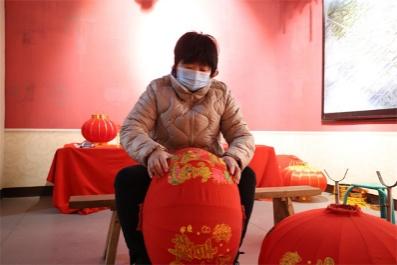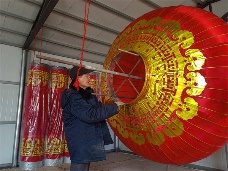
Bespoke palace lanterns on display at the Tuntou Lantern Museum near Shijiazhuang in North China’s Hebei Province. (Photos: Zhou Bo/People's Daily)
Some 70,000 people are employed in the manufacture of palace lanterns in Tuntou and its dozen surrounding villages.
The Gaochang gauze lanterns of an intangible cultural value hang in front of every Tuntou resident’s house during Chinese New Year as festive evidence of the evolution of a bespoke cottage industry into more than 1,100 factories with annual sales volume of more than 200 million lanterns.
Legend has it that when an Eastern Han Dynasty (25-220) emperor passed through the city of Gaocheng, he was so impressed by the lanterns hanging there that he brought them to decorate his palace.
Back then there were two basic types of palace lantern, as recognized by their addition to the province’s intangible cultural heritage list. Making them involved nearly 60 painstaking handicraft techniques.

A villager demonstrates lantern-making techniques at the Tuntou Palace Lantern Museum in Tuntou, North China’s Hebei Province.
In today’s Tuntou, a customer can choose from paper carved, rotating, small indoor and large outdoor palace lanterns.
Craftsman Bai Junping, 69, just made a lantern with a diameter of 6 meters.

Bai Junping tends to his jumbo illumination.
"Now that everyone can make ordinary red lanterns,” Bai says, “I have to keep researching and do something that no one else can do in order to sell at a good price.”
The manufacture process has developed into a more efficient industrial chain from making lantern skeletons in one group of villagers to packaging in another.
E-commerce is also broadening sales, with influencers marketing the village’s authentic lantern culture to the wider outside world.
(Compiled by Zhu Dan, Edited by Huang Jingjing)


